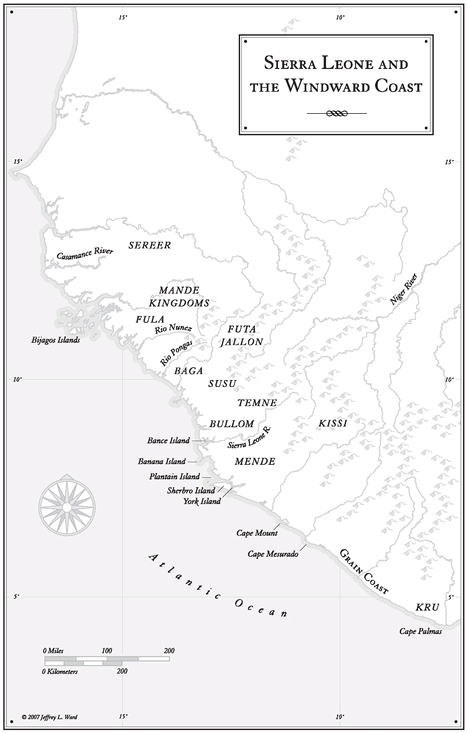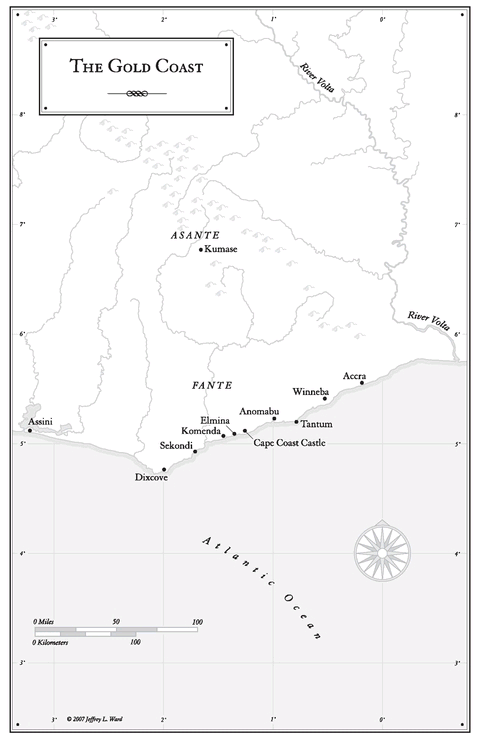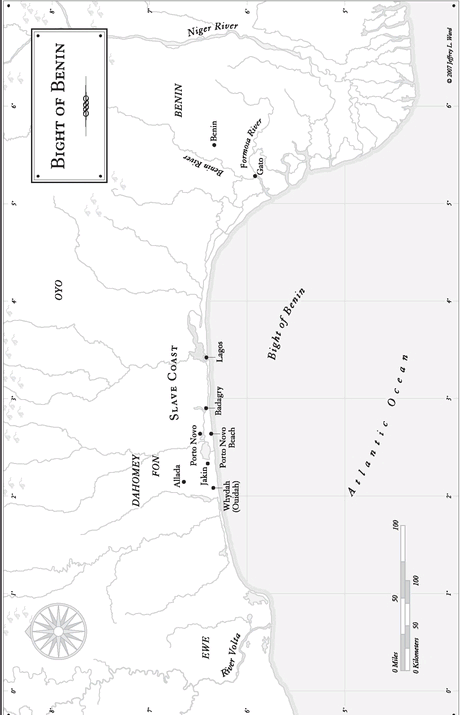The Slave Ship (13 page)
Authors: Marcus Rediker

Tucker’s region, Sierra Leone and the Windward Coast, was sometimes called the Upper Guinea Coast, although specific subregions were sometimes denominated the Grain Coast, the Ivory Coast, and the Malaguetta Coast. The area stretched from the Casamance River, along a zone of rain forest and very few good harbors, to the port of Assini at the edge of the Gold Coast, encompassing by today’s map Guinea-Bissau, Guinea, Sierra Leone, Liberia, and the Ivory Coast. In the eighteenth century, trade in this region was rather more varied than in other parts of the Guinea coast, involving slaves but also kola nuts, beeswax, camwood, gold, malaguetta peppers, and high-quality ivory. Slave-ship captains spent much time here buying rice as victuals for the Middle Passage.

The human geography of the region was one of the most complex of West Africa, as there existed few sizable states and a broad mosaic of ministates and cultural groups, some of which were converting to Islam but most of which were not. A majority of people lived in small-scale, egalitarian, communal villages and worked as farmers, fishermen, and hunters. Women seemed to have special power in certain areas and even took part in secret societies such as the Sande and Bundu. Political decentralization allowed traders like Henry Tucker to establish themselves along the coast, to organize production and exchange into the hinterland, and to accumulate wealth and power.
A range of smaller groups, such as the Baga, Bullom, and Kru, lived along the coast, while farther inland were the larger Susu, Temne, and Mende, as well as the increasingly Muslim Fulbe and Jallonke. Smaller groups in the interior included the Gola and Kissi (both said to be culturally like the Mende), and dozens of others such as the Ibau and Limba. In the Mane Wars of the late sixteenth and early seventeenth centuries, Mande speakers enslaved portions of smaller groups but were then themselves overrun by the Susu and the Fulbe. Islam spread beyond Senegambia into Sierra Leone and the Windward Coast as the Muslim theocracy of Futa Jallon conducted raids against those who practiced indigenous religions and sold them to Islamic traders in the north or coastal traders in the south. In the eighteenth century, approximately 460,000 people were enslaved and shipped out of this broad region, about 6.5 percent of the century’s total. More than 80 percent of them made the transatlantic voyage in British and American slavers.
14
Gold Coast14
John Kabes came into Fort Komenda “bawling” at the African traders from the interior of the Gold Coast. They were fools, he bellowed. They wanted too much for the slaves they were selling. How dare they ask for six ounces of gold rather than the customary four? He drove a hard bargain in the year 1714, just as he had been doing since 1683, working as a middleman between the African state of Eguafo, or Grand Commany, and European slavers. The English, the Dutch, and the French alternately wooed and vilified him. Without Kabes “nothing will be done” said an English factor; he is a turncoat and an “arrant coward,” snarled a Dutch one; we promise “high rewards,” added a hopeful Frenchman. He worked mostly with the English, for many years as an employee of the Royal African Company but not, in the parlance of the day, as its servant. He was a shrewd operator on his own behalf. He got three company agents fired because they could not work with him. “If we lose him our interest here is lost,” wrote one official to company authorities at Cape Coast Castle, fifteen miles away. Indeed it was Kabes who mobilized the labor that
built
Fort Komenda, the men who quarried the stone and cut the wood for the hulking imperial edifice. The Dutch, ensconced nearby at Fort Vredenburg, opposed the construction of the fortress, so Kabes led several military expeditions against them to encourage their assent. He subsequently built up a sizable town around the fortress. But most important of all, he traded slaves. Through the gates of Fort Komenda passed thousands of captives to one slave ship after another. By the time he died in 1722, Kabes had become a sovereign power in his own right, a merchant-prince who possessed his own “stool,” the ultimate symbol of political power among the Akan.
15
built
Fort Komenda, the men who quarried the stone and cut the wood for the hulking imperial edifice. The Dutch, ensconced nearby at Fort Vredenburg, opposed the construction of the fortress, so Kabes led several military expeditions against them to encourage their assent. He subsequently built up a sizable town around the fortress. But most important of all, he traded slaves. Through the gates of Fort Komenda passed thousands of captives to one slave ship after another. By the time he died in 1722, Kabes had become a sovereign power in his own right, a merchant-prince who possessed his own “stool,” the ultimate symbol of political power among the Akan.
15
The people of the Gold Coast had long traded with Europeans, originally, as the name signified, for the gleaming precious metal that spawned greed and massive fortresses, the first of which, at El Mina, was built by the Portuguese in 1482 to protect their golden hoard against Dutch, French, and English rivals. Eventually other European maritime powers, assisted by men like Kabes, came to build or seize forts of their own, which resulted in a string of fortifications along the five-hundred-mile coastline, from the port of Assini in the west to the river Volta in the east, the eastern portion of present-day Ivory Coast and most all of Ghana.
The English operated forts and trading establishments at Dixcove, Sekondi, Komenda, Anomabu, Accra, and Tantum; the seat of their operations was Cape Coast Castle. From these outposts traders loaded
 prisoners—black gold—into the lower decks of the ships. The building of the forts gave rise to ministates with
prisoners—black gold—into the lower decks of the ships. The building of the forts gave rise to ministates with
abirempon,
“big men” such as Kabes and John Konny. Many people who lived in the Gold Coast region in 1700 belonged to the broad cultural group the Akan (others were the Guan, the Etsi, and the Ga). The Akan were themselves divided into competitive, often antagonistic states, as Denkyira, Akwamu, and Akyem rose to prominence along the coast early in the century, with the assistance of European firearms. The new elite were called
awurafam,
“masters of firepower.” Political power grew out of the barrel of a gun.

abirempon,
“big men” such as Kabes and John Konny. Many people who lived in the Gold Coast region in 1700 belonged to the broad cultural group the Akan (others were the Guan, the Etsi, and the Ga). The Akan were themselves divided into competitive, often antagonistic states, as Denkyira, Akwamu, and Akyem rose to prominence along the coast early in the century, with the assistance of European firearms. The new elite were called
awurafam,
“masters of firepower.” Political power grew out of the barrel of a gun.
The mightiest group in the region was the Asante, whose rise after 1680 resulted in one of the strongest stratified and centralized states of West Africa. Osei Tutu built a regional alliance of “big men,” slowly incorporating various cultural groups under his central authority as
asantehene,
or ultimate leader, symbolized by the golden stool,
sika dwa
. The new Asante lords had brought several of the coastal ministates to heel by 1717 (adding Accra and Adangme in 1742) and continued their expansion in the north conquering smaller groups there, sending slaves northward with Hausa merchants and southward to the coast and the waiting slave ships. The Asante were skilled at war, as their very name, derived from
osa nit,
“because of war,” implied. “Real” Asantes, it was said, would not be sold into slavery. The powerful Asante army consisted in 1780 of eighty thousand men, half of them musketeers. Their slave trading over the course of the eighteenth century was a consequence of their war making and state building rather than a primary cause. Nonetheless it soon grew more profitable to catch slaves than to mine gold, and the Asante, despite their independence, became reliable players and valuable partners to the Europeans in the slave trade.
16
asantehene,
or ultimate leader, symbolized by the golden stool,
sika dwa
. The new Asante lords had brought several of the coastal ministates to heel by 1717 (adding Accra and Adangme in 1742) and continued their expansion in the north conquering smaller groups there, sending slaves northward with Hausa merchants and southward to the coast and the waiting slave ships. The Asante were skilled at war, as their very name, derived from
osa nit,
“because of war,” implied. “Real” Asantes, it was said, would not be sold into slavery. The powerful Asante army consisted in 1780 of eighty thousand men, half of them musketeers. Their slave trading over the course of the eighteenth century was a consequence of their war making and state building rather than a primary cause. Nonetheless it soon grew more profitable to catch slaves than to mine gold, and the Asante, despite their independence, became reliable players and valuable partners to the Europeans in the slave trade.
16
Another major player were the coastal Fante, whose confederation of nineteen independent polities developed as a reaction against the Asante. The Fante at times signed treaties with the British but continued to trade with slavers of several flags. They served the slave trade in myriad ways, selling people from inland regions and hiring out their own to work for wages on the slavers. Built from matrilineal clans, the Fante used their formidable military prowess to protect local autonomy, all within a highly commercialized orbit. They acted as middlemen, connecting the Asante in the interior to the English slavers on the coast. They would remain independent until conquered by the Asante in 1807, the year of abolition. Over the course of the eighteenth century, the Gold Coast produced more than a million slaves, about 15 percent of the total shipped from West Africa as a whole. Roughly two-thirds of the total were carried by British and American ships.
17
Bight of Benin17
The fishing village at the mouth of the Formosa River usually bustled with activity, but on this day in 1763 it was eerily quiet. Three people in a small canoe had come from far away and did not know the danger they were in. They might have wondered at the big ship, a brigantine, that lay at anchor a distance out in the Gulf of Benin, surrounded by ten war canoes. The
Briton
had come from even farther away. It belonged to Messrs. John Welch (or Welsh) and Edward Parr, merchants of Liverpool, and was captained by William Bagshaw. The war canoes, some of them large enough to have mounted six to eight swivel guns (small cannon), had come from upriver and belonged to a man named Captain Lemma Lemma, “a kind of pirate admiral” who traded in slaves. The people who lived on the lower river considered Lemma Lemma to be “a robber or stealer of men”; everyone was “exceedingly afraid of venturing out whenever any of his war canoes were in sight.” He was an important supplier of slaves to European Guineamen, which is why Captain Bagshaw had been entertaining him for ten days with food, drink, hospitality, and
dashee,
gifts to encourage sales.
Briton
had come from even farther away. It belonged to Messrs. John Welch (or Welsh) and Edward Parr, merchants of Liverpool, and was captained by William Bagshaw. The war canoes, some of them large enough to have mounted six to eight swivel guns (small cannon), had come from upriver and belonged to a man named Captain Lemma Lemma, “a kind of pirate admiral” who traded in slaves. The people who lived on the lower river considered Lemma Lemma to be “a robber or stealer of men”; everyone was “exceedingly afraid of venturing out whenever any of his war canoes were in sight.” He was an important supplier of slaves to European Guineamen, which is why Captain Bagshaw had been entertaining him for ten days with food, drink, hospitality, and
dashee,
gifts to encourage sales.
From the main deck of the slaver, Lemma Lemma spied the strangers paddling by and ordered a group of his canoemen to capture them. They deftly took to the water, seized the three—an old man, a young man, and a young woman—and brought them aboard, offering them
 for sale to Captain Bagshaw, who bought the younger two but refused the older one. Lemma Lemma sent the old man back to one of his canoes and gave an order: “his head was laid on one of the thwarts of the boat, and chopped off,” head and body then thrown overboard. Captain Bagshaw carried his children to Rappahannock, Virginia.
for sale to Captain Bagshaw, who bought the younger two but refused the older one. Lemma Lemma sent the old man back to one of his canoes and gave an order: “his head was laid on one of the thwarts of the boat, and chopped off,” head and body then thrown overboard. Captain Bagshaw carried his children to Rappahannock, Virginia.
18

18
The Bight of Benin, which lay between the Volta River and the Benin River (today’s Togo, Benin, and southwest Nigeria), had a turbulent history as a slave-trading region in the eighteenth century. During the previous century, Benin had been one of the first kingdoms to get large shipments of European firearms. Unlike the Asante, however, the peoples of Benin did not have the organizational capacity to use them, and they soon went into decline. Once-thriving regions near the coast were depopulated, their lands left uncultivated. Benin would remain the nucleus of various tributary states and societies, which would be connected to the slave ships by the likes of Captain Lemma Lemma.
The main cultural groups of the region were the Ewe to the west, consisting of more than a hundred small, autonomous village societies, the Fon in the central region (originally inland), and the more powerful and numerous Yoruba to the eastern interior, where they commanded the great Oyo Empire. Early in the eighteenth century, the main slaving ports were Whydah and Jakin, the port of Allada. These polities were independent until conquered by the Fon in the 1720s and 1730s and incorporated into Dahomey. Now that Dahomey’s King Agaja had eliminated the middlemen, he and his heirs built a strong, centralized, and relatively efficient state, organizing systematic raids and bending judicial processes to deliver slaves directly to the slave ships, although from a circumscribed hinterland that would in the long term limit slaving capacity. Dahomey maintained a standing army, with a storied regiment of women warriors, but the Dahomeans nonetheless began to pay tribute in the 1730s (regularly after 1747) to the more powerful neighboring Oyo, whose military strength in the heart-land was based on horses, cavalry, and control of the savanna. Long connected to the north-south caravan routes of the trans-Sahara slave trade, the Yoruba had by 1770 gained control of the ports of Porto Novo, Badagry, and, later in the eighteenth century, Lagos, although supplies to all would diminish with their own decline beginning in the 1790s. Altogether the Bight of Benin exported almost 1.4 million slaves in the eighteenth century, nearly a fifth of the total trade, but only about 15 percent of the total from the region were shipped by British and American slave vessels, which called increasingly to ports farther east.
19
19
Other books
Powers by Deborah Lynn Jacobs
After the Fall by Meikle, William
Lace by Shirley Conran
Romance of the Three Kingdoms II by Kuan-Chung, Lo
VIP by M. Robinson
An Elegant Façade (Hawthorne House Book #2) by Kristi Ann Hunter
Come, Reza, Ama by Elizabeth Gilbert
El viajero by Mandelrot
